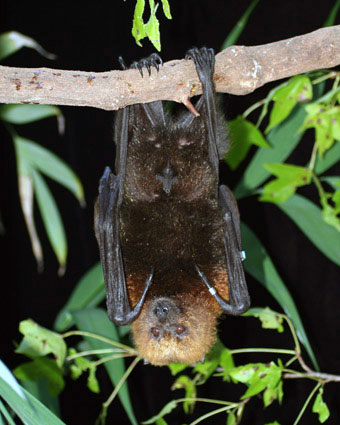Bat Not Blind as a Bat

It's an insult to fruit bats to call someone "blind as a bat." Scientists have long known that these banana-loving flying mammals have decent night vision.
And now research shows they can see just fine when the sun comes up too.
Bats come in two types—microbats (Microchiroptera), which actually are “blind as a bat” and use echolocation to get around and find their food, and fruit bats, or flying foxes (Megachiroptera), which have fairly large eyes equipped for vision.
For most mammals, the retina of the eye (the part that responds to light, like the film in a camera) has two types of photoreceptor cells, or neurons that absorb the light. The first type, called cones, are used for daylight and color vision, while the more sensitive rods are used for night vision.
Nocturnal bats were traditionally thought to only have rods (which are overwhelmed by the intense light of day), but scientists who observed fruit bats flying at twilight and occasionally during the day figured the bats must have some cones in their eyes.
So a team of scientists stained the retinas of several fruit bat species and found that while they did contain mostly rods, all of the species had a few cones, comprising about 0.5 percent of their photoreceptors.
“This share of cones appears small, but from studies of other night-active mammals we know that it allows daylight vision,” said study team leader Brigitte Müller of the Max Planck Institute in Germany. The results are detailed in the May 2007 online edition of the journal Brain, Behavior and Evolution.
Get the world’s most fascinating discoveries delivered straight to your inbox.
For example, cats and dogs actually only have 2 percent to 4 percent cones, and humans have only 5 percent.
The fruit bats’ daylight-sensitive cones help them stay alert to predatory birds while they roost in large open treetops during the day, but come dinnertime, the more sensitive rods are still the go-to photoreceptors.

Andrea Thompson is an associate editor at Scientific American, where she covers sustainability, energy and the environment. Prior to that, she was a senior writer covering climate science at Climate Central and a reporter and editor at Live Science, where she primarily covered Earth science and the environment. She holds a graduate degree in science health and environmental reporting from New York University, as well as a bachelor of science and and masters of science in atmospheric chemistry from the Georgia Institute of Technology.


